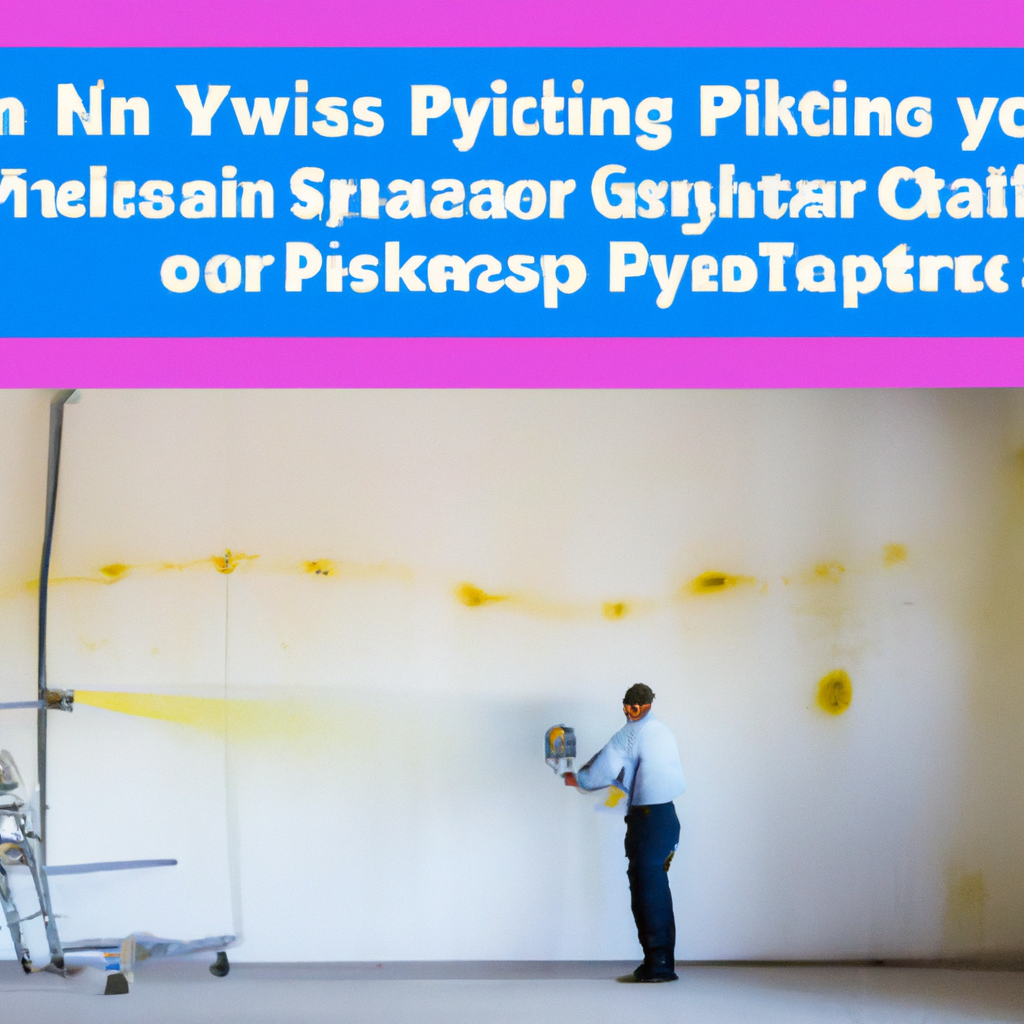
If you’ve ever wondered about the possibility of using a paint sprayer for your interior walls, then you’re in the right place. Painting your walls is a significant task, and finding the right tool can make a world of difference. In this article, we’ll explore the benefits and considerations of using a paint sprayer for your interior walls, helping you decide if it’s the right choice for you. So, let’s dive in and see if a paint sprayer is the key to achieving that flawless finish you’ve been dreaming of! Yes, you absolutely can! Using a paint sprayer for interior walls has numerous benefits that make the painting process faster, more efficient, and more consistent. In this article, we will explore the various benefits of using a paint sprayer, the different types of paint sprayers suitable for interior walls, how to prepare the walls before spraying, tips for using a paint sprayer effectively, common mistakes to avoid, safety precautions to take, and proper cleanup and maintenance steps. We will also briefly discuss alternatives to paint sprayers. So, let’s dive in and discover why using a paint sprayer on your interior walls can be a game-changer for your painting projects.
Benefits of Using a Paint Sprayer
Faster and more efficient application
One of the main advantages of using a paint sprayer for interior walls is the impressive speed and efficiency it provides. Compared to traditional methods like using brushes or rollers, a paint sprayer can cover larger areas in a significantly shorter amount of time. With a paint sprayer, you can expect to complete your painting projects in a fraction of the time it would take using traditional methods.
Consistent and smooth finish
Paint sprayers are known for delivering a smooth and uniform finish, leaving no brush marks or roller marks behind. The adjustable spray patterns of a paint sprayer allow for even coating, eliminating any unevenness that may occur with other methods. This consistency in finish gives your walls a professional and polished look.
Ability to reach difficult areas
With a paint sprayer, you can easily access and paint hard-to-reach areas such as corners, tight spaces, and intricate architectural details. These areas may be time-consuming and challenging to paint with brushes or rollers. The controlled and focused spray of a paint sprayer ensures that every nook and cranny of your interior walls receives an even coat of paint.
Types of Paint Sprayers for Interior Walls
Airless paint sprayers
Airless paint sprayers are versatile and suitable for various painting projects, including interior walls. They use a high-pressure system to atomize the paint, forcing it out through the spray tip in a fine mist. With an airless paint sprayer, you can achieve quick and even coverage, making it an excellent choice for larger areas.
HVLP paint sprayers
HVLP (High Volume Low Pressure) paint sprayers are known for their precision and control. They operate at a lower pressure than airless sprayers, resulting in less overspray and a softer spray pattern. HVLP sprayers are ideal for smaller interior wall projects that require more delicate application and detailed work.
Compressed air paint sprayers
Compressed air paint sprayers use compressed air to atomize the paint and propel it onto the surface. While they can produce a high-quality finish, they tend to have more overspray compared to airless or HVLP sprayers. Compressed air sprayers are commonly used by professional painters who are experienced in controlling overspray.

Preparing the Walls for Paint Spraying
Clean and prime the walls
Before using a paint sprayer on your interior walls, it is crucial to ensure they are clean and free of any dirt, dust, or debris. Use a mild detergent and water solution to wash the walls, followed by thorough rinsing and drying. Additionally, applying a primer can help create a smooth and even surface for the paint to adhere to, enhancing the overall finish.
Protect flooring and furniture
To prevent accidental paint splatters and spills, it is essential to protect your flooring and furniture. Lay down drop cloths or plastic covers to shield the floor and move any furniture out of the room if possible. If removing furniture is not an option, cover it with plastic sheets or old bedsheets to keep it safe from paint mist.
Mask off areas that should not be painted
Use painter’s tape to mask off areas that should not be painted, such as trim, windows, outlets, and switches. Take your time during this step to ensure precise and clean lines, as the tape will act as a barrier between the painted and unpainted surfaces. Proper masking ensures a professional-looking finish without any accidental paint marks in unwanted areas.
Choosing the Right Paint
Consider the type of paint sprayer being used
Different paint sprayers may require specific types of paint. Consult the manufacturer’s instructions or guidelines to determine the most suitable paint for your sprayer. Using paint that is not compatible with your sprayer can result in clogging or uneven application.
Opt for a paint specifically designed for spraying
When painting with a sprayer, it is recommended to use paints that are specifically formulated for spraying. These paints have a thinner consistency, allowing them to flow through the sprayer with ease. Using regular paint can lead to clogging, uneven application, and a less desirable finish.
Test the paint before fully committing
Before painting your entire interior wall, it is a good idea to test the paint on a small, inconspicuous area. This will allow you to assess the color, coverage, and consistency of the paint when applied with the sprayer. Testing the paint helps you make any necessary adjustments before committing to the full project.

Tips for Using a Paint Sprayer on Interior Walls
Practice on a test surface
If you are new to using a paint sprayer, it is essential to practice on a test surface before tackling your interior walls. This will help you get a feel for the sprayer, understand its spray pattern, and determine the optimal distance and speed for smooth application. Practicing beforehand will ensure more confidence and better results when painting your walls.
Maintain consistent distance and speed
To achieve an even coat of paint, it is crucial to maintain a consistent distance between the sprayer and the wall surface. This distance will vary depending on the type of sprayer and the paint being used, so refer to the manufacturer’s recommendations. Additionally, keep the sprayer moving at a steady speed to avoid heavy buildup of paint in one area.
Overlap each pass for even coverage
To ensure consistent and even coverage, overlap each pass of the sprayer by about 50%. This blending technique prevents any streaks or visible lines from appearing on the wall. Be mindful of your spray pattern and work methodically to avoid missing any areas or creating uneven spots.
Start from the top and work downwards
To minimize drips and runs, always start spraying from the top of the wall and work your way downwards. This allows any excess paint to be distributed evenly, and gravity helps prevent drips or streaks from forming. Working from top to bottom ensures a more controlled application and a smoother finish.
Apply multiple thin coats instead of one thick coat
When using a paint sprayer, it is best to apply multiple thin coats of paint rather than one thick coat. Thin coats dry faster, reduce the risk of drips, and provide better coverage. Building up the paint in layers allows for a more even distribution, resulting in a more professional-looking finish.
Common Mistakes to Avoid
Not properly preparing the walls
One of the most common mistakes when using a paint sprayer on interior walls is failing to prepare the walls adequately. Skipping the cleaning and priming steps can lead to poor paint adhesion and a subpar finish. Take the time to properly clean and prime the walls before spraying to ensure the best results.
Using the wrong type of paint
Using the wrong type of paint in your sprayer can cause clogging, uneven application, and unsatisfactory results. Always refer to the manufacturer’s instructions or guidelines to determine the appropriate paint for your specific sprayer. Using paint that is not compatible with your sprayer can result in frustration and wasted time.
Spraying too close or too far from the surface
Maintaining the correct distance between the sprayer and the wall surface is crucial for achieving a smooth and even finish. Spraying too close can result in oversaturation and uneven application, while spraying too far can lead to poor coverage and visible streaks. Follow the manufacturer’s recommendations for the optimal spraying distance.
Neglecting to cover or protect surrounding areas
Failing to protect surrounding areas such as flooring, furniture, and fixtures can result in unwanted paint splatters or spills. Take the time to cover and mask off these areas properly to prevent any damage or extra cleanup work. It is better to be safe than sorry when using a paint sprayer.
Excessive overspray
Overspray occurs when paint particles drift beyond the intended surface, resulting in wasted paint and potential damage to nearby items. Pay attention to the sprayer’s settings and adjust them accordingly to minimize overspray. Controlling overspray requires practice and technique, but it is an essential step in achieving a clean and efficient painting process.

Safety Precautions
Wear protective clothing, goggles, and a mask
When using a paint sprayer, it is crucial to protect yourself. Wear appropriate protective clothing, such as long sleeves, pants, and gloves, to shield your skin from paint splatters. Additionally, goggles will protect your eyes from any potential spray particles, and a mask will prevent you from inhaling any harmful fumes or fine paint particles.
Ensure proper ventilation in the workspace
Proper ventilation is essential when using a paint sprayer indoors to ensure a safe and healthy environment. Open windows, doors, or use fans to improve air circulation and remove any fumes that may be present. Adequate ventilation helps to disperse odors and maintain air quality during and after the painting process.
Keep children and pets away from the area
To prevent accidents and exposure to potentially harmful substances, it is important to keep children and pets away from the painting area. Paint sprayers can be noisy, and the chemicals in paint can be dangerous if ingested or inhaled. Create a safe and designated space where children and pets cannot accidentally come into contact with the paint or equipment.
Cleanup and Maintenance
Flush the paint sprayer with cleaning solution
After completing your painting project, it is crucial to clean the paint sprayer properly. Flush the sprayer with the recommended cleaning solution to remove any residual paint and prevent clogging. Follow the manufacturer’s instructions for the specific cleaning process, as different sprayers may have different requirements.
Clean the spray gun components thoroughly
In addition to flushing the paint sprayer, it is important to clean all the individual components of the spray gun thoroughly. Disassemble the gun and clean each part with the appropriate cleaning solution or water to remove any paint residue or buildup. This will ensure the longevity and optimal performance of your paint sprayer.
Store the paint sprayer properly
Proper storage of your paint sprayer is essential to protect it from damage and maintain its functionality. After cleaning and drying the sprayer, store it in a clean and dry place, away from extreme temperatures or moisture. Follow the manufacturer’s recommendations for specific storage instructions, as different sprayers may have varying requirements.

Alternatives to Paint Sprayers
Rollers
Rollers are a popular choice for painting interior walls, especially for beginners or smaller projects. They are easy to use and provide good coverage. Rollers can achieve a smooth finish, but they may leave visible texture on the walls. Additionally, using a roller can be more time-consuming compared to a paint sprayer.
Brushes
Using brushes is a traditional and precise method of painting interior walls. Brushes allow for intricate detailing and can easily reach tight corners and edges. While brushes are versatile, they can be time-consuming, especially for larger projects. Brush strokes may also be visible on the walls, resulting in a slightly different finish compared to using a sprayer or roller.
Conclusion
Using a paint sprayer for interior walls offers numerous benefits, including faster and more efficient application, a consistent and smooth finish, and the ability to reach difficult areas. By following the proper steps of preparing the walls, choosing the right paint, and using the paint sprayer effectively, you can achieve professional-looking results. However, it is important to be mindful of common mistakes to avoid and take the necessary safety precautions. Remember to properly clean and maintain your paint sprayer for long-lasting performance. While paint sprayers are a fantastic tool, alternatives such as rollers and brushes also have their place depending on the scope and requirements of your project. Whether you choose to use a paint sprayer or opt for a different method, the key is to enjoy the process and create the beautifully painted interior walls you desire. Happy painting!
